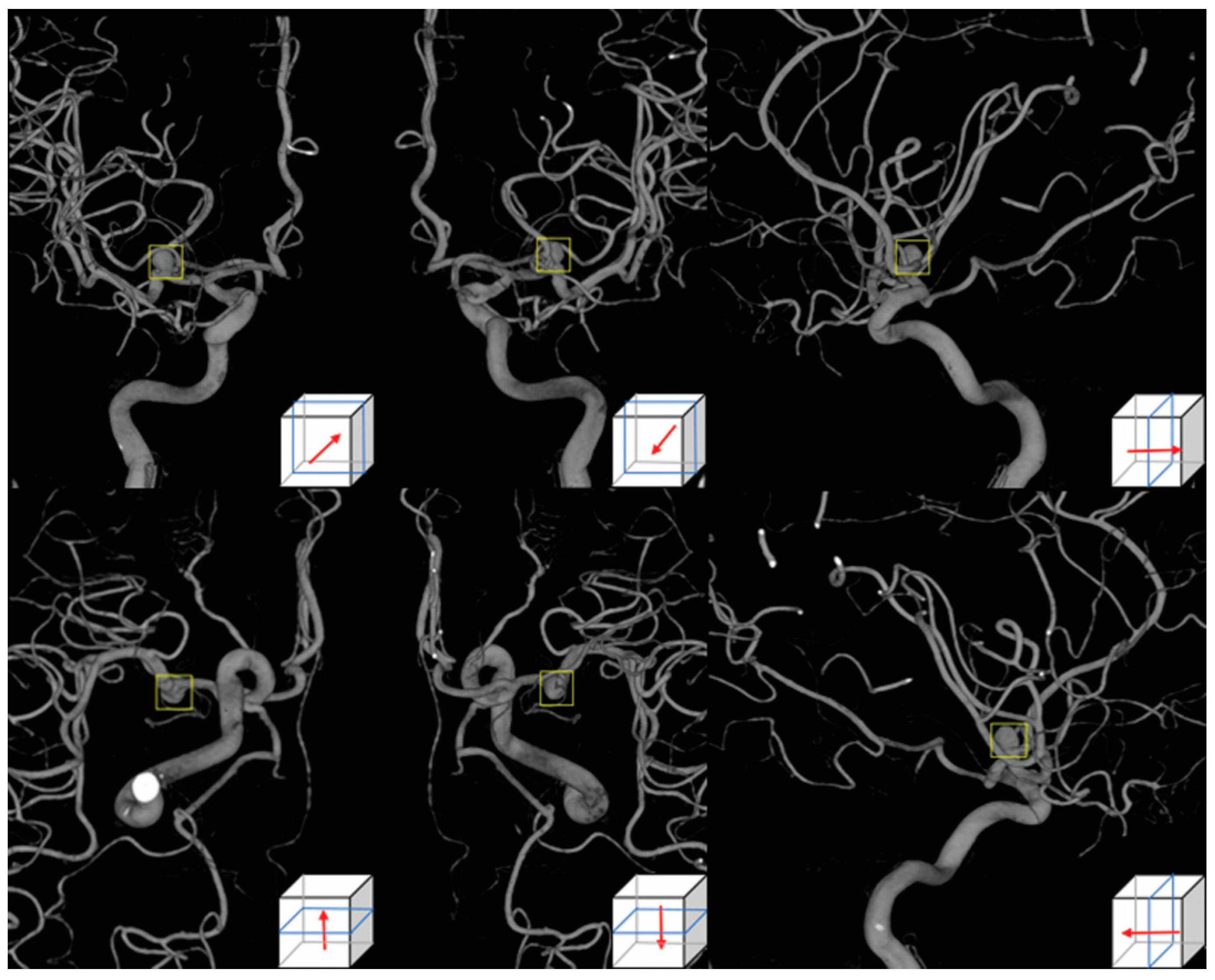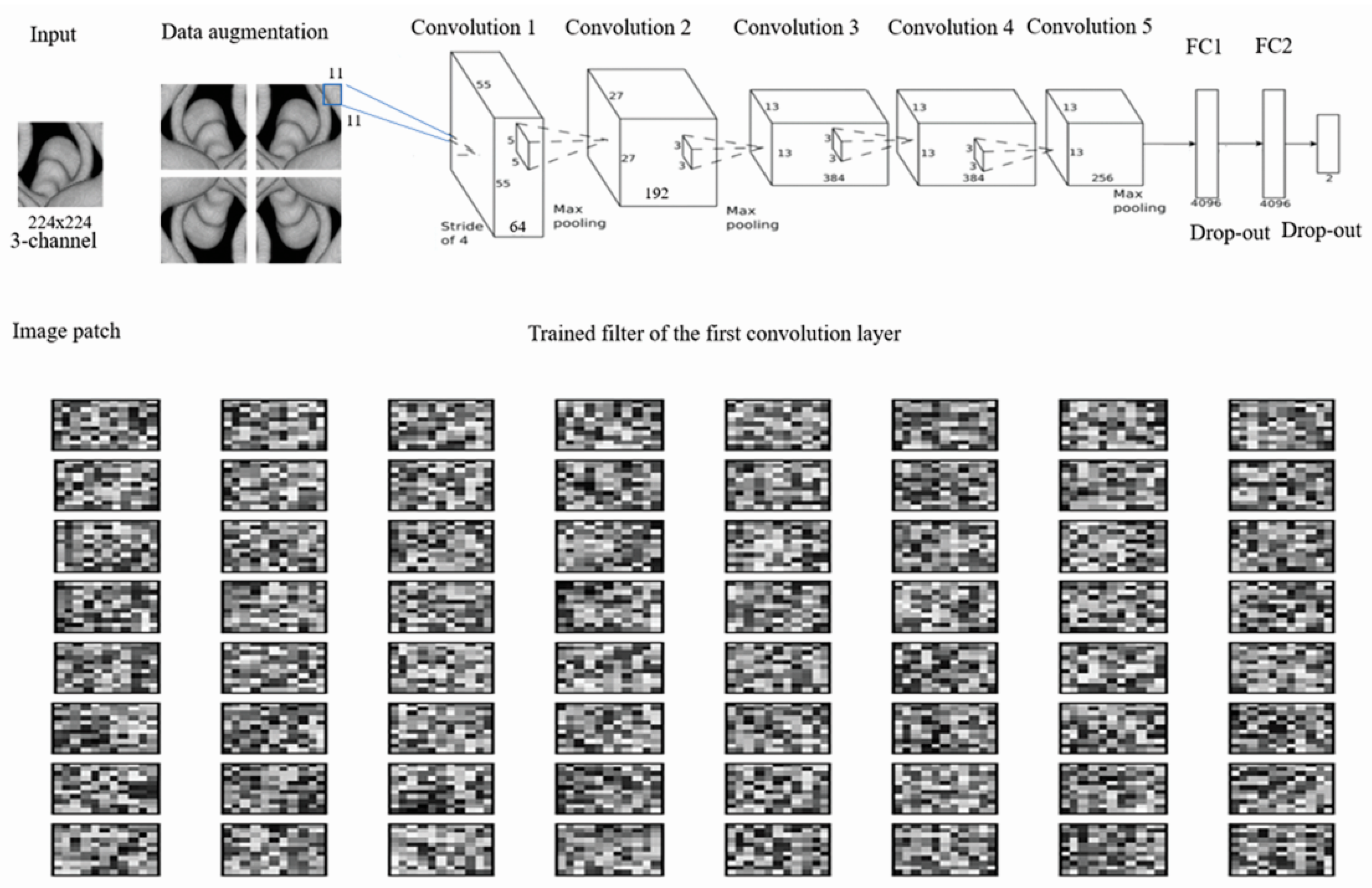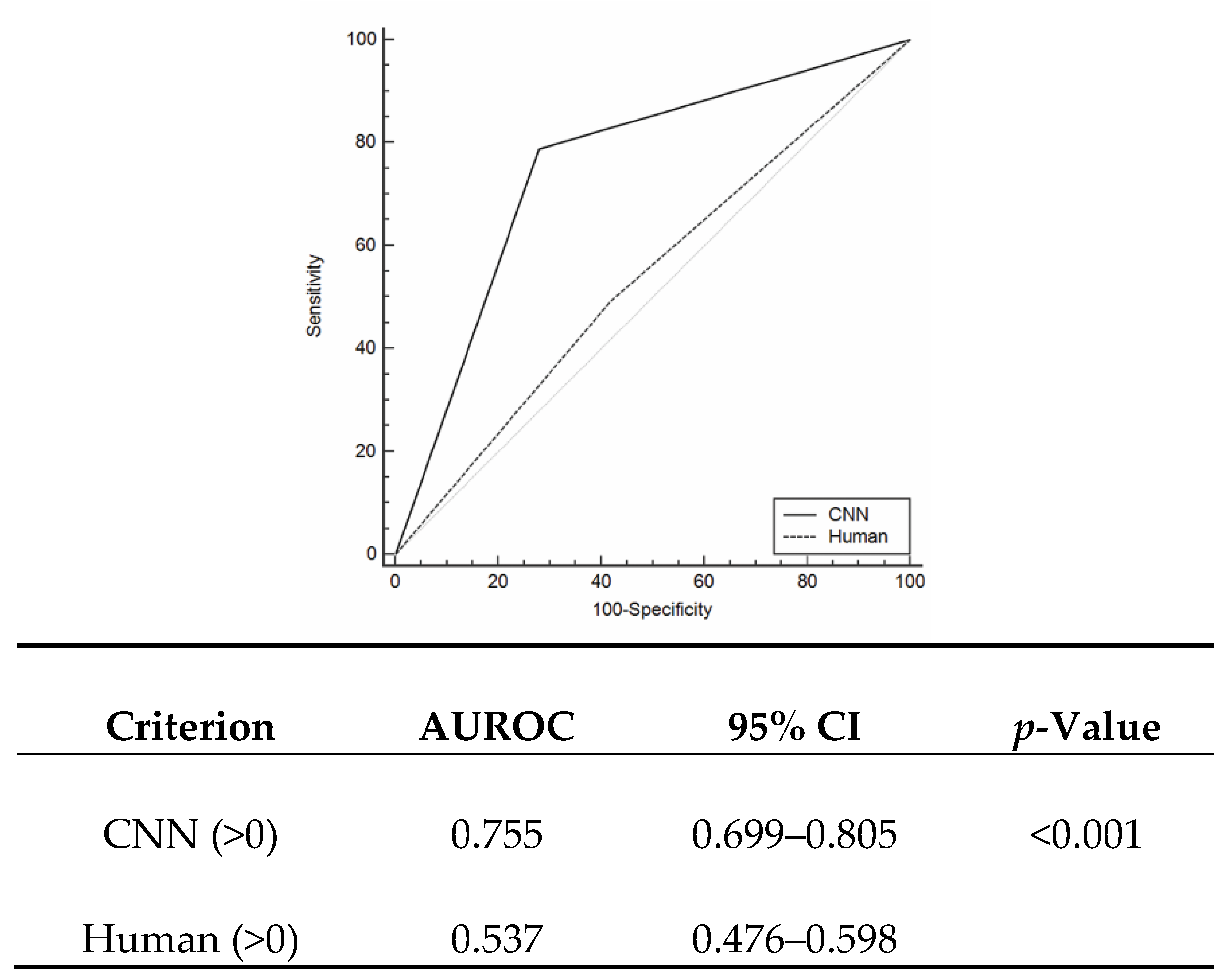Machine Learning Application for Rupture Risk Assessment in Small-Sized Intracranial Aneurysm
Abstract
1. Introduction
2. Materials and Methods
2.1. Study Population
2.2. Image Acquisition and Data Processing
2.3. Neural Network Architecture for Aneurysm Images
2.4. Statistical Analyses
3. Results
3.1. Clinical Characteristics of the Enrolled Patients
3.2. Accuracy of CNN for the Diagnosis of Ruptured Aneurysm
4. Discussion
5. Conclusions
Author Contributions
Funding
Conflicts of Interest
Abbreviations and Acronyms
References
- Vlak, M.H.; Algra, A.; Brandenburg, R.; Rinkel, G.J. Prevalence of unruptured intracranial aneurysms, with emphasis on sex, age, comorbidity, country, and time period: A systematic review and meta-analysis. Lancet Neurol. 2011, 10, 626–636. [Google Scholar] [CrossRef]
- Thompson, B.G.; Brown, R.D., Jr.; Amin-Hanjani, S.; Broderick, J.P.; Cockroft, K.M.; Connolly, E.S., Jr.; Duckwiler, G.R.; Harris, C.C.; Howard, V.J.; Johnston, S.C.; et al. Guidelines for the management of patients with unruptured intracranial aneurysms: A guideline for healthcare professionals from the american heart association/american stroke association. Stroke 2015, 46, 2368–2400. [Google Scholar] [CrossRef] [PubMed]
- Katati, M.J.; Santiago-Ramajo, S.; Perez-Garcia, M.; Jofré, M.M.S.; Vilar-Lopez, R.; Coin-Mejias, M.A.; Caracuel-Romero, A.; Arjona-Moron, V. Description of quality of life and its predictors in patients with aneurysmal subarachnoid hemorrhage. Cerebrovasc. Dis. 2007, 24, 66–73. [Google Scholar] [CrossRef] [PubMed]
- Lantigua, H.; Ortega-Gutierrez, S.; Schmidt, J.M.; Lee, K.; Badjatia, N.; Agarwal, S.; Claassen, J.; Connolly, E.S.; Mayer, S.A. Subarachnoid hemorrhage: Who dies, and why? Crit. Care 2015, 19, 309. [Google Scholar] [CrossRef] [PubMed]
- Bonita, R.; Thomson, S. Subarachnoid hemorrhage: Epidemiology, diagnosis, management, and outcome. Stroke 1985, 16, 591–594. [Google Scholar] [CrossRef] [PubMed]
- Juvela, S. Natural history of unruptured intracranial aneurysms: Risks for aneurysm formation, growth, and rupture. Acta Neurochir. Suppl. 2002, 82, 27–30. [Google Scholar] [PubMed]
- Clarke, G.; Mendelow, A.D.; Mitchell, P. Predicting the risk of rupture of intracranial aneurysms based on anatomical location. Acta Neurochir. (Wien) 2005, 147, 259–263. [Google Scholar] [CrossRef]
- Korja, M.; Lehto, H.; Juvela, S. Lifelong rupture risk of intracranial aneurysms depends on risk factors: A prospective finnish cohort study. Stroke 2014, 45, 1958–1963. [Google Scholar] [CrossRef] [PubMed]
- Jeon, J.S.; Ahn, J.H.; Huh, W.; Son, Y.J.; Bang, J.S.; Kang, H.S.; Sohn, C.H.; Oh, C.W.; Kwon, O.K.; Kim, J.E. A retrospective analysis on the natural history of incidental small paraclinoid unruptured aneurysm. J. Neurol. Neurosurg Psychiatry 2014, 85, 289–294. [Google Scholar] [CrossRef] [PubMed]
- Aubreville, M.; Knipfer, C.; Oetter, N.; Jaremenko, C.; Rodner, E.; Denzler, J.; Bohr, C.; Neumann, H.; Stelzle, F.; Maier, A. Automatic classification of cancerous tissue in laserendomicroscopy images of the oral cavity using deep learning. Sci. Rep. 2017, 7, 11979. [Google Scholar] [CrossRef] [PubMed]
- Esteva, A.; Kuprel, B.; Novoa, R.A.; Ko, J.; Swetter, S.M.; Blau, H.M.; Thrun, S. Dermatologist-level classification of skin cancer with deep neural networks. Nature 2017, 542, 115–118. [Google Scholar] [CrossRef] [PubMed]
- Nakao, T.; Hanaoka, S.; Nomura, Y.; Sato, I.; Nemoto, M.; Miki, S.; Maeda, E.; Yoshikawa, T.; Hayashi, N.; Abe, O. Deep neural network-based computer-assisted detection of cerebral aneurysms in mr angiography. J. Magn. Reson. Imaging 2018, 47, 948–953. [Google Scholar] [CrossRef] [PubMed]
- Stember, J.N.; Chang, P.; Stember, D.M.; Liu, M.; Grinband, J.; Filippi, C.G.; Meyers, P.; Jambawalikar, S. Convolutional neural networks for the detection and measurement of cerebral aneurysms on magnetic resonance angiography. J. Digit. Imaging 2018. [Google Scholar] [CrossRef] [PubMed]
- McDowell, M.M.; Zhao, Y.; Kellner, C.P.; Barton, S.M.; Sussman, E.; Claassen, J.; Ducruet, A.F.; Connolly, E.S. Demographic and clinical predictors of multiple intracranial aneurysms in patients with subarachnoid hemorrhage. J. Neurosurg. 2018, 128, 961–968. [Google Scholar] [CrossRef]
- Nehls, D.G.; Flom, R.A.; Carter, L.P.; Spetzler, R.F. Multiple intracranial aneurysms: Determining the site of rupture. J. Neurosurg. 1985, 63, 342–348. [Google Scholar] [CrossRef] [PubMed]
- Hino, A.; Fujimoto, M.; Iwamoto, Y.; Yamaki, T.; Katsumori, T. False localization of rupture site in patients with multiple cerebral aneurysms and subarachnoid hemorrhage. Neurosurgery 2000, 46, 825–830. [Google Scholar] [PubMed]
- Jeon, J.P.; Kim, C.; Oh, B.D.; Kim, S.J.; Kim, Y.S. Prediction of persistent hemodynamic depression after carotid angioplasty and stenting using artificial neural network model. Clin. Neurol. Neurosurg. 2018, 164, 127–131. [Google Scholar] [CrossRef] [PubMed]
- Jeon, J.S.; Sheen, S.H.; Hwang, G.J.; Kim, H.C.; Kwon, B.J. Feasibility of intravenous flat panel detector ct angiography for intracranial arterial stenosis. AJNR Am. J. Neuroradiol. 2013, 34, 129–134. [Google Scholar] [CrossRef] [PubMed]
- Jou, L.D.; Mohamed, A.; Lee, D.H.; Mawad, M.E. 3d rotational digital subtraction angiography may underestimate intracranial aneurysms: Findings from two basilar aneurysms. AJNR Am. J. Neuroradiol. 2007, 28, 1690–1692. [Google Scholar] [CrossRef]
- Lu, L.; Zhang, L.J.; Poon, C.S.; Wu, S.Y.; Zhou, C.S.; Luo, S.; Wang, M.; Lu, G.M. Digital subtraction ct angiography for detection of intracranial aneurysms: Comparison with three-dimensional digital subtraction angiography. Radiology 2012, 262, 605–612. [Google Scholar] [CrossRef]
- Sekhar, L.N.; Tariq, F.; Mai, J.C.; Kim, L.J.; Ghodke, B.; Hallam, D.K.; Bulsara, K.R. Unyielding progress: Treatment paradigms for giant aneurysms. Clin. Neurosurg. 2012, 59, 6–21. [Google Scholar] [CrossRef] [PubMed]
- International Study of Unruptured Intracranial Aneurysms Investigators. Unruptured intracranial aneurysms—risk of rupture and risks of surgical intervention. N. Engl. J. Med. 1998, 339, 1725–1733. [Google Scholar] [CrossRef] [PubMed]
- Wiebers, D.O.; Whisnant, J.P.; Huston, J., 3rd; Meissner, I.; Brown, R.D., Jr.; Piepgras, D.G.; Forbes, G.S.; Thielen, K.; Nichols, D.; O’Fallon, W.M.; et al. Unruptured intracranial aneurysms: Natural history, clinical outcome, and risks of surgical and endovascular treatment. Lancet 2003, 362, 103–110. [Google Scholar] [CrossRef]
- Dolati, P.; Pittman, D.; Morrish, W.F.; Wong, J.; Sutherland, G.R. The frequency of subarachnoid hemorrhage from very small cerebral aneurysms (<5 mm): A population-based study. Cureus 2015, 7, e279. [Google Scholar] [PubMed]
- Williams, L.N.; Brown, R.D., Jr. Management of unruptured intracranial aneurysms. Neurol. Clin. Pract. 2013, 3, 99–108. [Google Scholar] [CrossRef]
- Xiang, J.; Natarajan, S.K.; Tremmel, M.; Ma, D.; Mocco, J.; Hopkins, L.N.; Siddiqui, A.H.; Levy, E.I.; Meng, H. Hemodynamic-morphologic discriminants for intracranial aneurysm rupture. Stroke 2011, 42, 144–152. [Google Scholar] [CrossRef]
- Boussel, L.; Rayz, V.; McCulloch, C.; Martin, A.; Acevedo-Bolton, G.; Lawton, M.; Higashida, R.; Smith, W.S.; Young, W.L.; Saloner, D. Aneurysm growth occurs at region of low wall shear stress: Patient-specific correlation of hemodynamics and growth in a longitudinal study. Stroke 2008, 39, 2997–3002. [Google Scholar] [CrossRef] [PubMed]
- Malek, A.M.; Alper, S.L.; Izumo, S. Hemodynamic shear stress and its role in atherosclerosis. JAMA 1999, 282, 2035–2042. [Google Scholar] [CrossRef] [PubMed]
- Hassan, T.; Timofeev, E.V.; Saito, T.; Shimizu, H.; Ezura, M.; Matsumoto, Y.; Takayama, K.; Tominaga, T.; Takahashi, A. A proposed parent vessel geometry-based categorization of saccular intracranial aneurysms: Computational flow dynamics analysis of the risk factors for lesion rupture. J. Neurosurg. 2005, 103, 662–680. [Google Scholar] [CrossRef] [PubMed]
- Shojima, M.; Oshima, M.; Takagi, K.; Torii, R.; Hayakawa, M.; Katada, K.; Morita, A.; Kirino, T. Magnitude and role of wall shear stress on cerebral aneurysm: Computational fluid dynamic study of 20 middle cerebral artery aneurysms. Stroke 2004, 35, 2500–2505. [Google Scholar] [CrossRef] [PubMed]
- Laukamp, K.R.; Thiele, F.; Shakirin, G.; Zopfs, D.; Faymonville, A.; Timmer, M.; Maintz, D.; Perkuhn, M.; Borggrefe, J. Fully automated detection and segmentation of meningiomas using deep learning on routine multiparametric MRI. Eur. Radiol. 2019, 29, 124–132. [Google Scholar] [CrossRef] [PubMed]
- Sailer, A.M.; Wagemans, B.A.; Nelemans, P.J.; de Graaf, R.; van Zwam, W.H. Diagnosing intracranial aneurysms with mr angiography: Systematic review and meta-analysis. Stroke 2014, 45, 119–126. [Google Scholar] [CrossRef] [PubMed]
- Sugahara, T.; Korogi, Y.; Nakashima, K.; Hamatake, S.; Honda, S.; Takahashi, M. Comparison of 2d and 3d digital subtraction angiography in evaluation of intracranial aneurysms. AJNR Am. J. Neuroradiol. 2002, 23, 1545–1552. [Google Scholar]
- Tykocki, T.; Kostkiewicz, B. Aneurysms of the anterior and posterior cerebral circulation: Comparison of the morphometric features. Acta Neurochir. (Wien) 2014, 156, 1647–1654. [Google Scholar] [CrossRef] [PubMed]
- Yu, W.; Yang, K.; Bai, Y.; Yao, H.; Rui, Y. Visualizing and comparing AlexNet and VGG using deconvolutional layers. In Proceedings of the 33rd International Conference on Machine Learning, New York, NY, USA, 19–24 June 2016. [Google Scholar]



| Training Cohort | Test Cohort | ||
|---|---|---|---|
| Variables | (n = 368) | (n = 272) | p-Value |
| Clinical findings | |||
| Female | 175 (47.6%) | 145 (53.3%) | 0.150 |
| Age, years | 57.8 ± 14.4 | 55.8 ± 16.3 | 0.101 |
| Hypertension | 89 (24.2%) | 72 (26.5%) | 0.510 |
| Diabetes mellitus | 37 (10.1%) | 28 (10.3%) | 0.921 |
| Hyperlipidemia | 38 (10.3%) | 21 (7.7%) | 0.260 |
| Smoking | 44 (12.0%) | 27 (9.9%) | 0.419 |
| Radiologic findings | |||
| Lesion side, left | 172 (46.7%) | 127 (46.7%) | 0.990 |
| SAH presentation | 244 (66.3%) | 193 (71.0%) | 0.294 |
| Size (mm) | 5.3 ± 1.0 | 5.2 ± 1.1 | 0.231 |
| Territory location | |||
| Anterior cerebral artery | 123 (33.4%) | 96 (35.3%) | 0.265 |
| Middle cerebral artery | 133 (36.1%) | 82 (30.1%) | |
| Internal cerebral artery | 112 (30.5%) | 94 (34.6%) |
| Ruptured | Unruptured | Total | |
|---|---|---|---|
| Ruptured | 152 | 22 | 176 |
| Unruptured | 41 | 57 | 96 |
| Total | 193 | 79 | 272 |
© 2019 by the authors. Licensee MDPI, Basel, Switzerland. This article is an open access article distributed under the terms and conditions of the Creative Commons Attribution (CC BY) license (http://creativecommons.org/licenses/by/4.0/).
Share and Cite
Kim, H.C.; Rhim, J.K.; Ahn, J.H.; Park, J.J.; Moon, J.U.; Hong, E.P.; Kim, M.R.; Kim, S.G.; Lee, S.H.; Jeong, J.H.; et al. Machine Learning Application for Rupture Risk Assessment in Small-Sized Intracranial Aneurysm. J. Clin. Med. 2019, 8, 683. https://doi.org/10.3390/jcm8050683
Kim HC, Rhim JK, Ahn JH, Park JJ, Moon JU, Hong EP, Kim MR, Kim SG, Lee SH, Jeong JH, et al. Machine Learning Application for Rupture Risk Assessment in Small-Sized Intracranial Aneurysm. Journal of Clinical Medicine. 2019; 8(5):683. https://doi.org/10.3390/jcm8050683
Chicago/Turabian StyleKim, Heung Cheol, Jong Kook Rhim, Jun Hyong Ahn, Jeong Jin Park, Jong Un Moon, Eun Pyo Hong, Mi Ran Kim, Seung Gyu Kim, Seong Hwan Lee, Jae Hoon Jeong, and et al. 2019. "Machine Learning Application for Rupture Risk Assessment in Small-Sized Intracranial Aneurysm" Journal of Clinical Medicine 8, no. 5: 683. https://doi.org/10.3390/jcm8050683
APA StyleKim, H. C., Rhim, J. K., Ahn, J. H., Park, J. J., Moon, J. U., Hong, E. P., Kim, M. R., Kim, S. G., Lee, S. H., Jeong, J. H., Choi, S. W., & Jeon, J. P. (2019). Machine Learning Application for Rupture Risk Assessment in Small-Sized Intracranial Aneurysm. Journal of Clinical Medicine, 8(5), 683. https://doi.org/10.3390/jcm8050683





